

This was going to be a good test for the 5.7 and 10 gigahertz transverter setups and new tower. Gene, NØDQS and I had made attempts during the 2002 June Contest to make contacts on those bands. We had technical difficulties, and had to scrap those bands for the contest. Shortly thereafter, I pretty much discovered the things that were wrong and got everything fixed up. What it amounted to was that we had ended up blowing the front end gasfets due to relay isolation problems. We had made a number of attempts afterwards and got everything working prior to the UHF Contest. ( See the 5.7 and 10Ghz project Write-up for more details ) We were definitely looking to see how many grids could be worked on the high bands. I was also hoping that we would get propagation like we did in the last years UHF contest. Last year was awesome and we actually had QRM on number of the UHF and microwave bands. That made it a lot of fun and we hoped that things would be the same.
As the WX came to be, it was not going to be a stellar weekend. Thunderstorms blew through and actually cut into Gene’s grid hopping count. The last grids I got him in Saturday night had him cranking the dishes up in the rain, making the contacts, then driving as fast as he could south east to beat a large T-storm bearing down on him. (He was up in SW Minnesota at the time) Look at the massive frontal boundary below. This thing messed up the contest for a lot of folks!
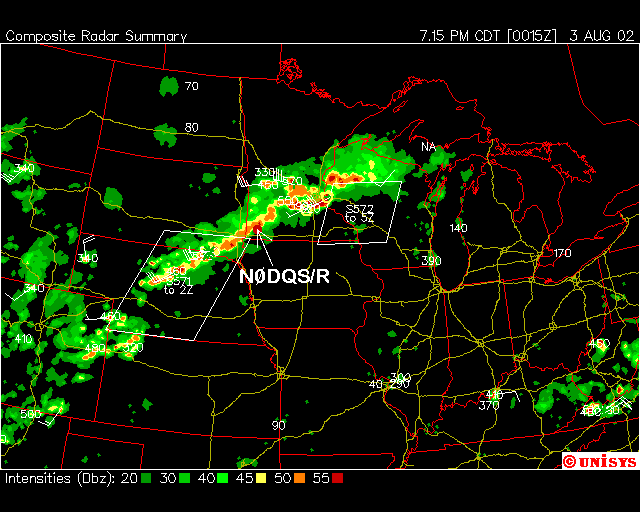
Quite noticeable was the rain flutter on the signals on 2304 and up, especially 5.7 and 10 Ghz. Kind of auroral sounding in some cases. It made it interesting for sure. I kept track of the real time radar images for the area via the internet and reported to Gene every few minutes on the status of the storm line. This kept him out of the very active portion of the front as it pushed through.
Click this link for the radar information as shown above.
The "Hybrid"
One thing that worked out extraordinarily well was what I called the "Hybrid" 5.7 Ghz system that Gene was running on the rover. During the June Contest, I thought we had fried the rover RX gasfet on the 5.7 Ghz (and 10Ghz) transverter. I got the 10 Ghz units working, but 5.7 was still an issue. The problem did not appear to be the front end after all. Knowing that I had reached my end of technical expertise in this area, I was going to have to send it in for repair to Gerry at SSB Electronics. However this was messing with the timeline of this years end of the CSVHF "States Above 50 Mhz" operating event. I had till the end of June to run up a few more states on the band, and could not hear anything on the 5.7 Ghz rover transverter. The transmitter with it’s 250 mW was working fine on the DB6NT unit.
I called Steve at DEMI and got one of his low power transverters for 5.7 Ghz and was going to mount that on the dish for Gene to run out to Nebraska and a few other places. As I began to implement this new unit into the design, I accidentally grounded the external relay driver output pin. ( thinking it was ground, they are right next to one another – Be Warned! ) Well, this fried the pc board relay inside the transverter that drove the external TX/RX relay, so after that, it only could work on receive.
After I picked up all the junk I threw around the ham shack in haste J I began to think, "Well, could I combine both units? One works on TX and one on RX!"
So I looked around a dug up a few SMA relays and some UT-141 SMA cables. I took the 144 Mhz IF input to the common port on one relay and then to the normally closed contact to the IF input of the DEMI unit. I took the normally open path (closed on TX condition) to the DB6NT transverter IF input.
On the output, I combined the 5760 Mhz RX input on the DEMI unit and the TX output of the DB6NT to another SMA relay. I used the TX +12V output of the DB6NT transverter to drive both relays. (The +12V is delivered on PTT condition) I also put a dummy load on the DEMI transverter TX output just to be safe. I put nothing on the RX input of the DB6NT transverter, that part was already broke! In addition, I was sure to also key the DEMI unit on PTT so it was not receiving during the TX condition of the DB6NT unit. See the diagram below….
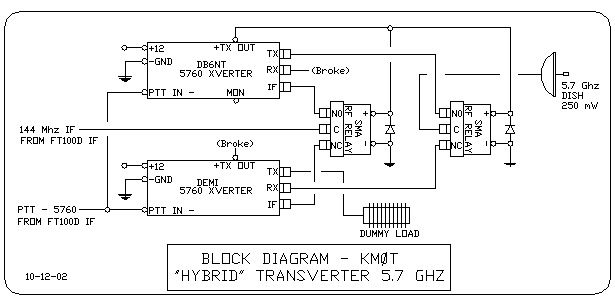
Anyway, I mounted the "Hybrid" on the dish with of combination of wood, duct tape and some other wallboard material. It was a true hodgepodge in the spirit of Ham Radio! See the pictures below.
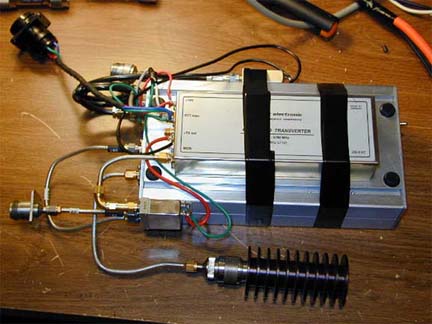


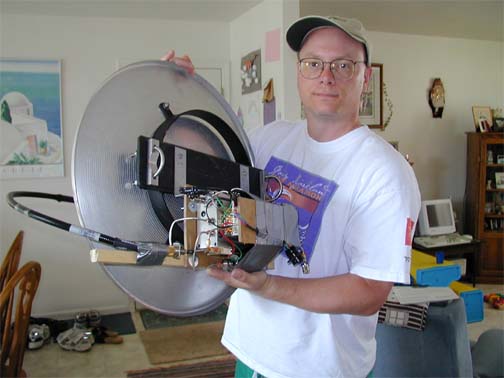


Anyway, field testing went very well and Gene worked "split" on his FT-100D IF rig, because the local oscillators of both transverters were around 60 to 80 kilohertz apart. Once we found each other, everything worked great. I managed to get the final states I needed for the CSVHF "States" event! The "Hybrid" unit was working so well, I decided not to change it for the UHF Contest!
Contest Summary: KMØT
Well, there were basically no conditions to speak of. And the WX did not help the activity level. Most contacts were local area, no real DX except Bill, KØAWU up in EN37 on 432. Below is a summary. OH! Gene – NØDQS/R and I made it on 5.7 and 10 Ghz in his 8 grids, that was our goal and the equipment worked great. It was our first real effort on these bands and we both learned a ton on how to point the dishes and get the QSO as quick as we could without too much screwing around. Oh, with all that weather that NØDQS/R drove thru, the 5.7 "Hybrid" did not get too wet, Gene had put a bag around it with some more duct tape. I still found some water spots on the inside on the transverter boards after the contest, but it was still working FB!
| Band | QSOs | Pts | QSO Pts | Grids |
| 222 MHZ | 20 | 3 | 60 | 12 |
| 432 MHZ | 26 | 3 | 78 | 13 |
| 902 MHZ | 10 | 6 | 60 | 9 |
| 1296 MHZ | 13 | 6 | 78 | 10 |
| 2304 MHZ | 10 | 12 | 120 | 9 |
| 3456 MHZ | 9 | 12 | 108 | 9 |
| 5760 MHZ | 8 | 12 | 96 | 8 |
| 10368 MHZ | 8 | 12 | 96 | 8 |
| Totals All Bands | 104 | 696 | 78 |
KMØT CLAIMED SCORE: 54,288
Not anywhere close to last year with the propagation and band openings we had then. (184 QSOs and 138,312 points in 2001)
"The Rover’s Corner" ©
What can I say, the rovers helped out. Here is the chart of Rover activity I worked:
| BAND | NØDQS/R | WØAMT/R | KCØGKF/R |
| 222 MHZ | 8 | 3 | |
| 432 MHZ |
8 |
3 | 1 |
| 902 MHZ | 8 | ||
| 1296 MHZ | 8 | ||
| 2304 MHZ | 8 | ||
| 3456 MHZ | 8 | ||
| 5760 MHZ | 8 | ||
| 10368 MHZ | 8 | ||
| Total Qsos | 64 | 6 | 1 |
Total Rover QSOs = 71
Rover QSOs % of Total QSOs = 68% WOW! The rovers really were necessary! This really shows how the activity dropped off this contest due to bad conditions.
A special thanks to all the rovers. Without contacts from them, the score would be next to nothing!
GRID CHARTS
Here are some grid charts showing the extent worked on the various bands. These where clipped from Vqlog. I was able to export in ADIF format for my contest data from VHFDX (which I feel is superior in speed and ease of use for logging these VHF contests) The data transfers very quickly to Vqlog without any problems. The neat thing about Vqlog is that it has the ability to generate graphs, maps and charts based on the QSO data.
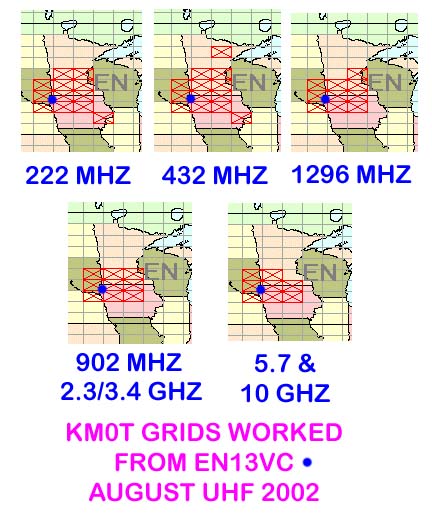
This was the first contest that I got to have both girls in the shack! Patricia and Jenna took some time out to see Dad during the operations! Jenna really liked all the different colored lights!
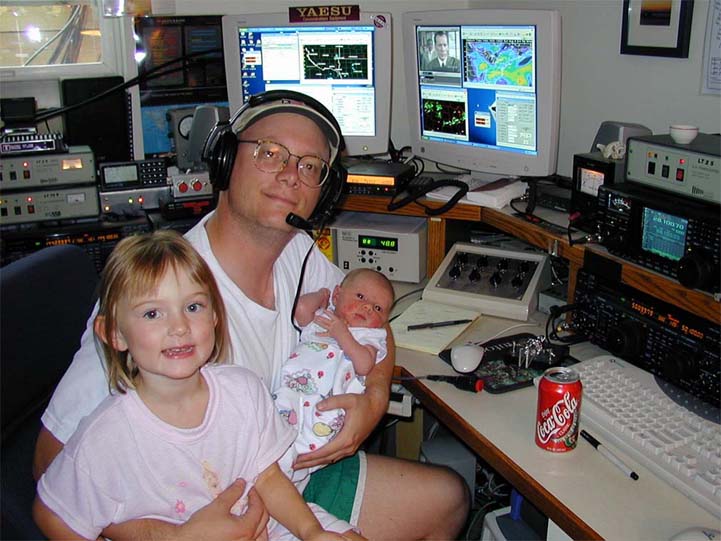
Well, better propagation next time hopefully!
73 and See You Next Contest!
Mike - KMØT EN13vc